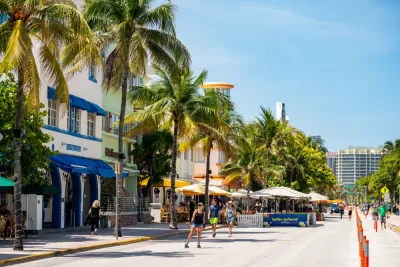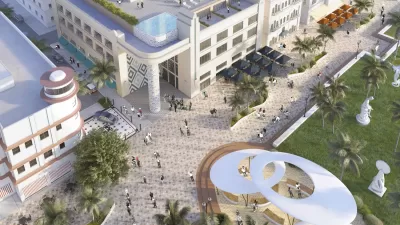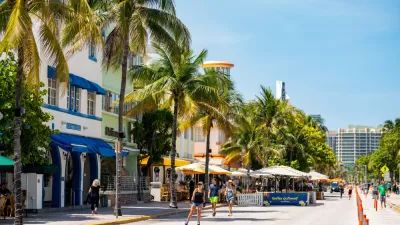Ocean Drive in South Beach is the site of an ongoing pilot project in making space for pedestrians and businesses in space previously devoted to cars. Advocates and some local politicians don't like the direction that the experiment is headed.

"For nearly eight weeks, a sliver of South Beach belonged to the people," writes Martin Vassolo. "There were no cars allowed on a 10-block stretch of Ocean Drive, the popular seaside promenade, giving bicyclists, skateboarders, joggers and walkers a space to exercise away from cramped sidewalks and congested roads."
Now that has changed, however, after the city returned cars to the northbound lanes on Ocean Drive over the 4th of July weekend, while retaining the southbound lanes for pedestrians and outdoor dining, in what promises to be an ongoing experiment in reconfiguring the public realm in response to ongoing crises of public health and the local economy.
"Mayor Dan Gelber said the street’s new configuration will not be permanent, calling it a 'two-week pilot' program," according to Vassolo. "Ideally, he said, the city should be able to fully pedestrianize the street during certain periods, and open it to cars the rest of the time."
Activists, however, are still pushing back on the decision to allow cars back onto the street. "Activists aren’t the only ones perplexed by the city’s decision to reopen Ocean Drive. Commissioners Ricky Arriola and Mark Samuelian, who supported the closure of the street, said on Friday they were not consulted about the plan," reports Vassolo.
Additional coverage of the ongoing Ocean Drive saga is available from Joshua Ceballos.
FULL STORY: Ocean Drive was closed to cars for eight weeks. Miami Beach is reopening a lane of traffic

Alabama: Trump Terminates Settlements for Black Communities Harmed By Raw Sewage
Trump deemed the landmark civil rights agreement “illegal DEI and environmental justice policy.”

Planetizen Federal Action Tracker
A weekly monitor of how Trump’s orders and actions are impacting planners and planning in America.

The 120 Year Old Tiny Home Villages That Sheltered San Francisco’s Earthquake Refugees
More than a century ago, San Francisco mobilized to house thousands of residents displaced by the 1906 earthquake. Could their strategy offer a model for the present?

In Both Crashes and Crime, Public Transportation is Far Safer than Driving
Contrary to popular assumptions, public transportation has far lower crash and crime rates than automobile travel. For safer communities, improve and encourage transit travel.

Report: Zoning Reforms Should Complement Nashville’s Ambitious Transit Plan
Without reform, restrictive zoning codes will limit the impact of the city’s planned transit expansion and could exclude some of the residents who depend on transit the most.

Judge Orders Release of Frozen IRA, IIJA Funding
The decision is a victory for environmental groups who charged that freezing funds for critical infrastructure and disaster response programs caused “real and irreparable harm” to communities.
Urban Design for Planners 1: Software Tools
This six-course series explores essential urban design concepts using open source software and equips planners with the tools they need to participate fully in the urban design process.
Planning for Universal Design
Learn the tools for implementing Universal Design in planning regulations.
Clanton & Associates, Inc.
Jessamine County Fiscal Court
Institute for Housing and Urban Development Studies (IHS)
City of Grandview
Harvard GSD Executive Education
Toledo-Lucas County Plan Commissions
Salt Lake City
NYU Wagner Graduate School of Public Service





























